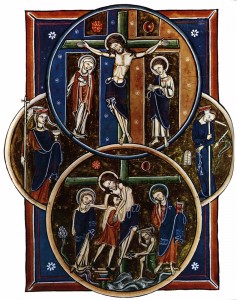“You know the depths of shame to which my unbridled lust had consigned our bodies, until no reverence for decency or for God even during the days of Our Lord’s Passion, or of the greater sacraments could keep me from wallowing in this mire. Even when you were unwilling, resisted to the utmost of your power and tried to dissuade me, as yours was the weaker nature I often forced you to consent with threats and blows.* So intense were the fires of lust which bound me to you that I set those wretched, obscene pleasures, which we must blush even to name, above God as above myself; nor would it seem that divine mercy could have taken action except by forbidding me these pleasures altogether, without future hope.” Abelard to Heloise, Letter 5 in The Letters of Abelard and Heloise. Trans. Betty Radice, Revised edition by M.T. Clanchy (Penguin: London, 2003), p. 81. [Emphasis added]
As if he wanted to surpass Heloise’s shocking statement about loving him more than God, Abelard describes his lustful actions and mistreatment of her in graphic terms. He clearly understood that he took advantage of the situation. When they met, he was around 35 and she was in her late teens. By all accounts, she possessed a great intellect and her letters indicate this fact. Abelard deflects Heloise’s admission of continued love for him by heaping blame on his own emotional instability and deeds of shame.
Pleading his own unworthiness, Abelard exhorts Heloise to turn her heart toward divine love. He instructs her to remember Christ’s Passion for the salvation of the world, not theirs for the sake of lusts. Like the women along the road to Calvary, he wants Heloise to weep for the Son of God:
“Have compassion on him who suffered willingly for your redemption, and look with remorse on him who was crucified for you. In your mind always be present at his tomb, weep and wail with the faithful women.” Ibid., p. 85.
Abelard wants Heloise to replace the images of their passionate embraces stamped on her heart with the image of Christ’s Passion in her memory. In so doing, his prescribed meditation reflects that of many twelfth-century theologians. For example, Bernard of Clairvaux instructed his monks to “preserve without fail the memory of all those biter things he [Jesus] endured for you.” https://wp.cune.edu/matthewphillips/2014/08/20/bernards-memoria/
To summarize Abelard’s exhortation: Meditate on the crucified Christ. Turn your sorrow to Him because Jesus “set up the Cross, from which he summons us, as a ladder for us to use. On this, for you, the only begotten Son of God was killed; he was made an offering because he wished it. Grieve with compassion over him alone and share his suffering in grief.” Ibid., p. 85. 
Following this section, Abelard weds spiritual marriage to the teaching of Christ’s redemption. This fits with Heloise’s new vocation as a nun, but it also applied to every Christian soul. He explained to Heloise that Christ had redeemed her with his own blood. In this way, Christ has demonstrated an inestimable love for Heloise, unlike Abelard’s unbridled lust:
“To him, I beseech you, not to me, should be directed to all your devotion, all your compassion, all your remorse. Weep for the injustice of the great cruelty inflicted on him, not for the just and righteous payment demanded of me, or rather, as I said, the supreme grace granted us both….Mourn for your Saviour and Redeemer, not for your corrupter and fornicator; wail for the Lord who died for you, not for the servant who lives and, indeed, for the first time is truly freed from death.” Ibid., p. 86.
*The issue of physical abuse here is truly disturbing*
